Molybdenum Oxides Coatings for High Demanding Accelerator Components
Abstract
:1. Introduction
2. Materials and Methods
3. Results and Discussion
3.1. Evaluation of MoO3 Films Thicknesses
3.2. Study of Mechanical Properties of MoO3 Films on Copper
4. Conclusions
Author Contributions
Funding
Acknowledgments
Conflicts of Interest
References
- Graedel, T.E.; Harper, E.M.; Nassar, N.T.; Reck, B.K. On the materials basis of modern society. Proc. Natl. Acad. Sci. USA 2013, 112, 6295–6300. [Google Scholar] [CrossRef] [PubMed]
- Pritzkau, D.P.; Siemann, R.H. Experimental study of rf pulsed heating on oxygen free electronic copper. Phys. Rev. Spec. Top. Accel. Beams 2002, 5, 112002. [Google Scholar] [CrossRef]
- Carter, R.G. Acceleration technologies for charged particles: An introduction. Contemp. Phys. 2011, 52, 15–41. [Google Scholar] [CrossRef]
- Döbert, S.; Adolphsen, C.; Bowden, G.; Burke, D.; Chan, J.; Dolgashev, V.; Frisch, J.; Jobe, K.; Jones, R.; Lewandowski, J.; et al. High Gradient Performance of NLC/GLC X-Band Accelerating Structures. In Proceedings of the 2005 Particle Accelerator Conference, Knoxville, TN, USA, 16–20 May 2005. [Google Scholar]
- Bini, S.; Chimenti, V.; Marcelli, A.; Palumbo, L.; Spataro, B.; Dolgashev, V.A.; Tantawi, S.; Yeremian, A.D.; Higashi, Y.; Grimaldi, M.G.; et al. Development of X-band accelerating structures for high gradients. Chin. Phys. C 2012, 36, 639–647. [Google Scholar] [CrossRef]
- Kwan, T.; Dawson, J.M.; Lin, A.T. Free electron laser. Phys. Fluids 1997, 36, 486–506. [Google Scholar]
- Deacon, D.A.G.; Elias, L.R.; Madey, J.M.J.; Ramian, G.J.; Schwettman, H.A.; Smith, T.I. First Operation of a Free-Electron Laser. Phys. Rev. Lett. 1977, 38, 892–894. [Google Scholar] [CrossRef]
- Antoine, C.Z.; Peauger, F.; Le Pimpec, F. Electromigration occurrences and its effects on metallic surfaces submitted to high electromagnetic field: A novel approach to breakdown in accelerators. Nucl. Instrum. Methods Phys. Res. Sect. A 2011, 665, 54–69. [Google Scholar] [CrossRef]
- Knobloch, J. Advanced Thermometry Studies of Superconducting Radio Frequency Cavities. Ph.D. Thesis, Cornell University, Ithaca, NY, USA, 1997; p. 285. [Google Scholar]
- Norem, J.; Insepov, Z.; Konkashbaev, I. Triggers for RF breakdown. Nucl. Instrum. Methods Phys. Res. Sect. A 2005, 537, 510–520. [Google Scholar] [CrossRef]
- Insepov, Z.; Norem, J.; Proslier, T.; Huang, D.; Mahalingam, S.; Veitzer, S. Modeling RF breakdown arcs. arXiv 2011, arXiv:1003.1736. [Google Scholar]
- Dolgashev, V.A.; Tantawi, S.G.; Nantista, C.D.; Higashi, Y.; Higo, T. RF breakdown in normal conducting single-cell structures. In Proceedings of the 2005 Particle Accelerator Conference, Knoxville, TN, USA, 16–20 May 2005. [Google Scholar]
- Wang, J.W. R&D of Accelerator Structures at SLAC; SLAC-PUB-12293; Stanford Linear Accelerator Center (SLAC): Menlo Park, CA, USA, 2007. [Google Scholar]
- Guignard, G. CLIC Study Team. CERN 2000-008. July 2000. [Google Scholar]
- Dolgashev, V.; Tantawi, S.; Yeremian, A.; Higashi, Y.; Spataro, B. Status of high power tests of normal conducting single-cell standing wave structures. In Proceedings of the 1st International Particle Accelerator Conference (IPAC 2010), Kyoto, Japan, 23–28 May 2010. [Google Scholar]
- Dolgashev, V.A. High Gradient, X-Band and above, Metallic RF structures. In Proceedings of the AAC2015, Isola d’Elba, Italy, 13–19 September 2015. [Google Scholar]
- Belli, E.; Pinto, P.C.; Rumolo, G.; Sapountzis, A.; Sinkovits, T.; Taborelli, M.; Spataro, B.; Zobov, M.; Castorina, G.; Migliorati, M. Electron cloud buildup and impedance effects on beam dynamics in the Future Circular e+e− Collider and experimental characterization of thin TiZrV vacuum chamber coatings. Phys. Rev. Accel. Beams 2018, 21, 111002. [Google Scholar] [CrossRef]
- Ferrario, M.; Alesini, D.; Anania, M.; Artioli, M.; Bacci, A.; Bartocci, S.; Bedogni, R.; Bellaveglia, M.; Biagioni, A.; Bisesto, F.; et al. EuPRAXIA@SPARC_LAB Design study towards a compact FEL facility at LNF. Nuclear Instrum. Methods Phys. Res. Sect. A 2018, 909, 134–138. [Google Scholar] [CrossRef]
- Vaccarezza, C.; Alesini, D.; Bacci, A.; Cianchi, A.; Chiadroni, E.; Croia, M.; Diomede, M.; Ferrario, M.; Gallo, A.; Giribono, A.; et al. EUPRAXIA@SPARC_LAB: Beam dynamics studies for the X-band Linac. Nuclear Instrum. Methods Phys. Res. Sect. A 2018, 909, 314–317. [Google Scholar] [CrossRef]
- Giribono, A.; Bacci, A.; Chiadroni, E.; Cianchi, A.; Croia, M.; Ferrario, M.; Marocchino, A.; Petrillo, V.; Pompili, R.; Romeo, S.; et al. EuPRAXIA@SPARC_LAB: The high-brightness RF photo-injector layout proposal. Nuclear Instrum. Methods Phys. Res. Sect. A 2018, 909, 282–285. [Google Scholar] [CrossRef]
- Marcelli, A.; Spataro, B.; Sarti, S.; Dolgashev, V.A.; Tantawi, S.; Yeremian, D.A.; Higashi, Y.; Parodi, R.; Notargiacomo, A.; Xu, J.; et al. Characterization of thick conducting molybdenum films: Enhanced conductivity via thermal annealing. Surf. Coat. Technol. 2015, 261, 391–397. [Google Scholar] [CrossRef]
- Cahill, A.; Dolgashev, V.; Rosenzweig, J.; Tantawi, S.; Weathersby, S. Ultra high gradient breakdown rates in X-Band cryogenic normal conducting RF accelerating cavities. In Proceedings of the 8th International Particle Accelerator Conference (IPAC 2017), Copenhagen, Denmark, 14–19 May 2017; p. THPIK125. [Google Scholar]
- Marcelli, A.; Spataro, B.; Castorina, G.; Xu, W.; Sarti, S.; Monforte, F.; Cibin, G. Materials and Breakdown Phenomena: Heterogeneous Molybdenum Metallic Films. Condensed Matter 2017, 2, 18. [Google Scholar] [CrossRef]
- Orlandi, G.; Scalambrin, F.; Hauer, M.; Calatroni, S.; Benvenuti, C. Niobium coatings for 1.5 GHz RF cavities. No. CERN-MT-93-13-SM. P00019445. 1993. [Google Scholar]
- Macis, S.; Aramo, C.; Bonavolontà, C.; Cibin, G.; D’Elia, A.; Davoli, I.; De Lucia, M.; Lucci, M.; Lupi, S.; Miliucci, M.; et al. MoO3 films grown on polycristalline Cu: Morphological, structural, and electronic properties. J. Vac. Sci. Technol. A 2019, 37, 021513. [Google Scholar] [CrossRef]
- Macis, S. Deposition and Characterization of Thin MoO3 Films on Cu for Technological Applications. Ph.D. Thesis, Tor Vergata University, Rome, Italy, 2018. [Google Scholar]
- Sunu, S.; Prabhu, E.; Jayaraman, V.; Gnanasekar, K.; Gnanasekaran, T. Gas sensing properties of PLD made MoO3 films. Sens. Actuators B Chem. 2003, 94, 189–196. [Google Scholar] [CrossRef]
- Ramana, C.V.; Atuchin, V.V.; Pokrovsky, L.D.; Becker, U.; Julien, C.M. Structure and chemical properties of molybdenum oxide thin films. J. Vac. Sci. Technol. A 2007, 25, 1166–1171. [Google Scholar] [CrossRef]
- Ramana, C.V.; Julien, C.M. Chemical and electrochemical properties of molybdenum oxide thin films prepared by reactive pulsed-laser assisted deposition. Chem. Phys. Lett. 2006, 428, 114–118. [Google Scholar] [CrossRef]
- Hampai, D.; Cherepennikov, Y.M.; Liedl, A.; Cappuccio, G.; Capitolo, E.; Iannarelli, M.; Azzutti, C.; Gladkikh, Y.P.; Marcelli, A.; Dabagov, S.B. Polycapillary based µXRF station for 3D colour tomography. J. Instrum. 2018, 13, C04024. [Google Scholar] [CrossRef]
- Moseley, H.G.J.; Jeffreys, H.G. XCIII. The high-frequency spectra of the elements. Lond. Edinb. Dublin Philos. Mag. J. Sci. 1913, 26, 1024–1034. [Google Scholar] [CrossRef]
- Oliver, W.; Pharr, G. An improved technique for determining hardness and elastic modulus using load and displacement sensing indentation experiments. J. Mater. Res. 1992, 7, 1564–1583. [Google Scholar] [CrossRef]
- Doerner, M.F.; William, D.N. A method for interpreting the data from depth-sensing indentation instruments. J. Mater. Res. 1986, 1, 601–609. [Google Scholar] [CrossRef]
- Oliver, W.C.; Georges, M.P. Measurement of hardness and elastic modulus by instrumented indentation: Advances in understanding and refinements to methodology. J. Mater. Res. 2004, 19, 3–20. [Google Scholar] [CrossRef]
- Li, X.; Bharat, B. A review of nanoindentation continuous stiffness measurement technique and its applications. Mater. Charact. 2002, 48, 11–36. [Google Scholar] [CrossRef]
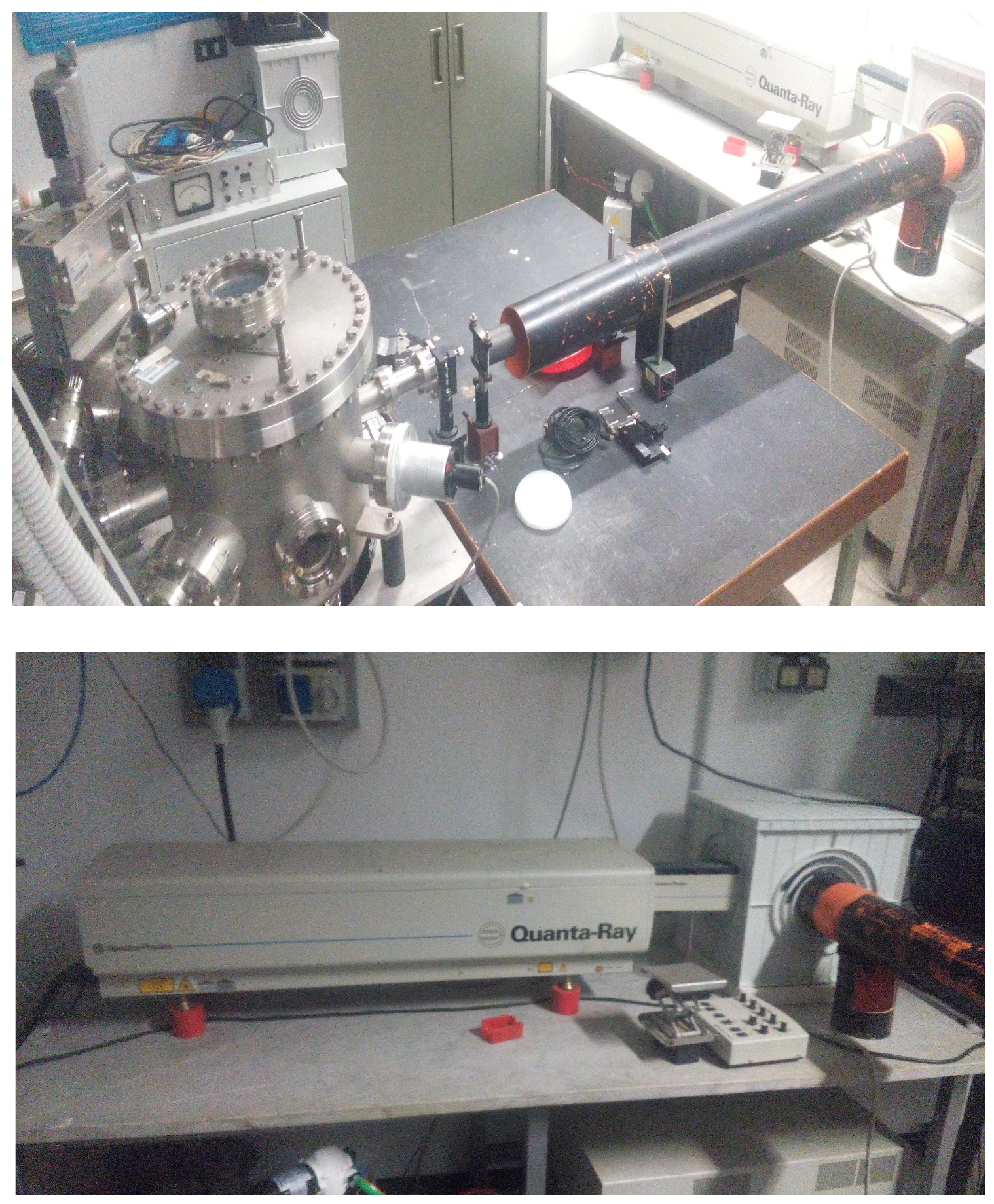
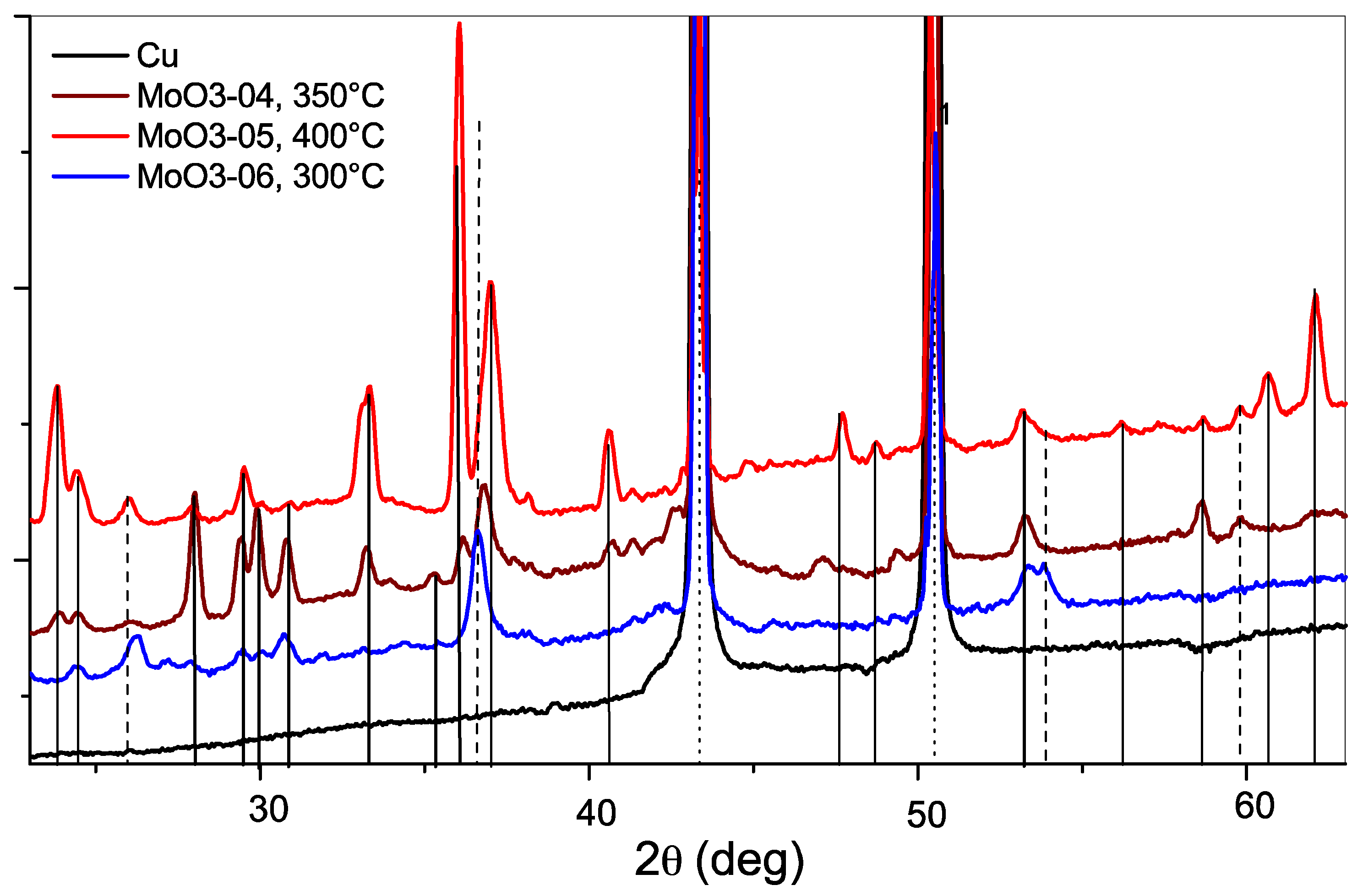

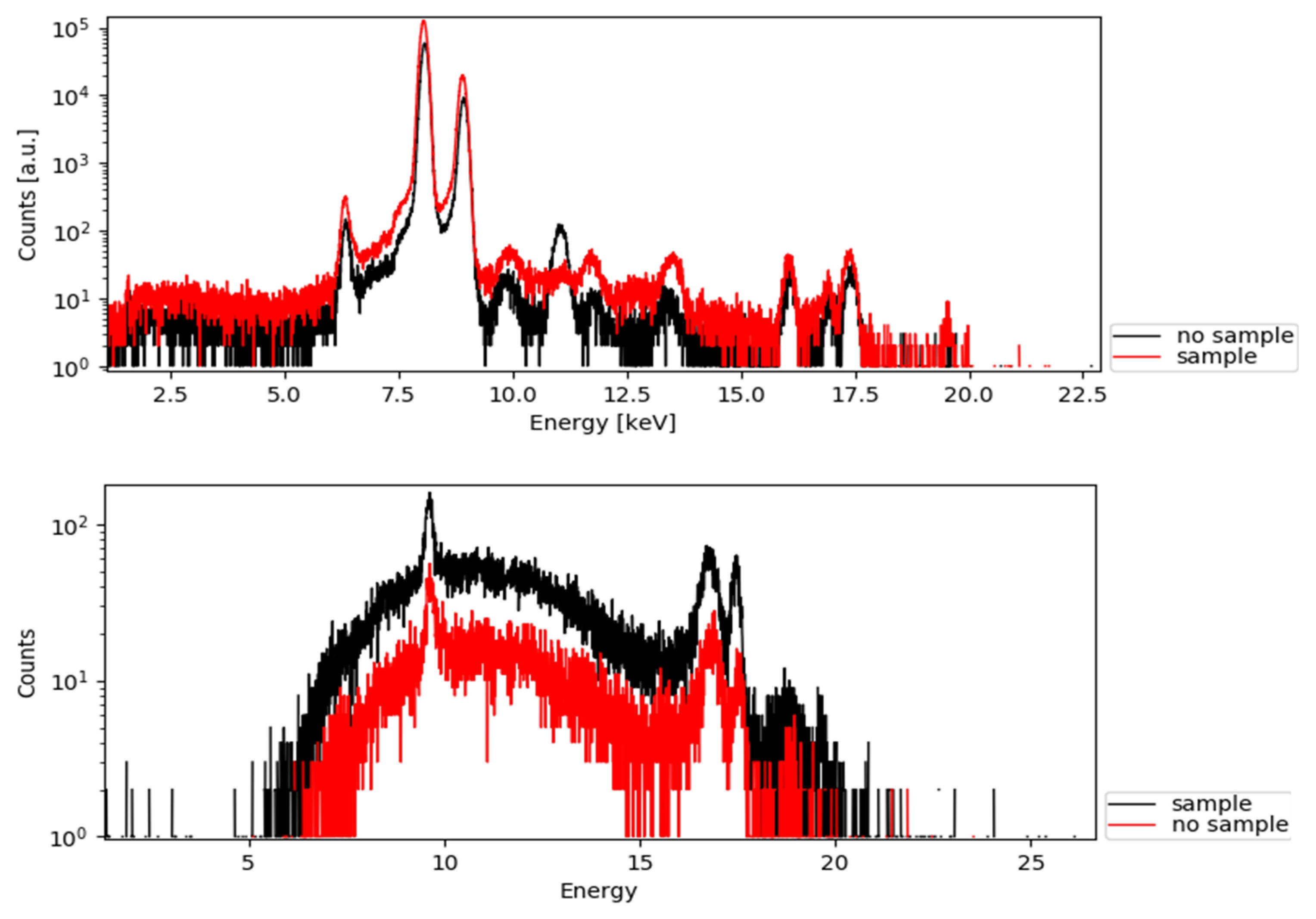
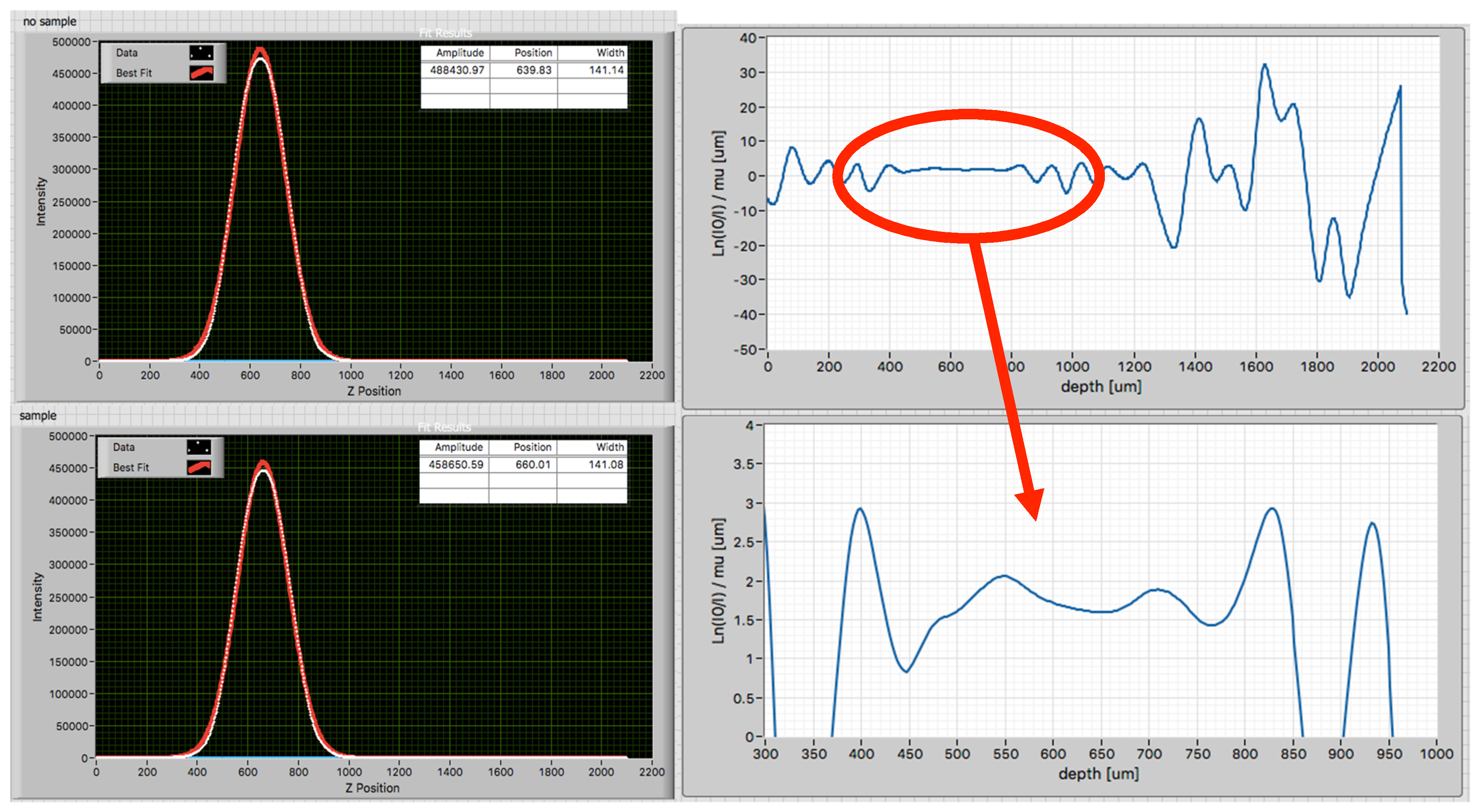
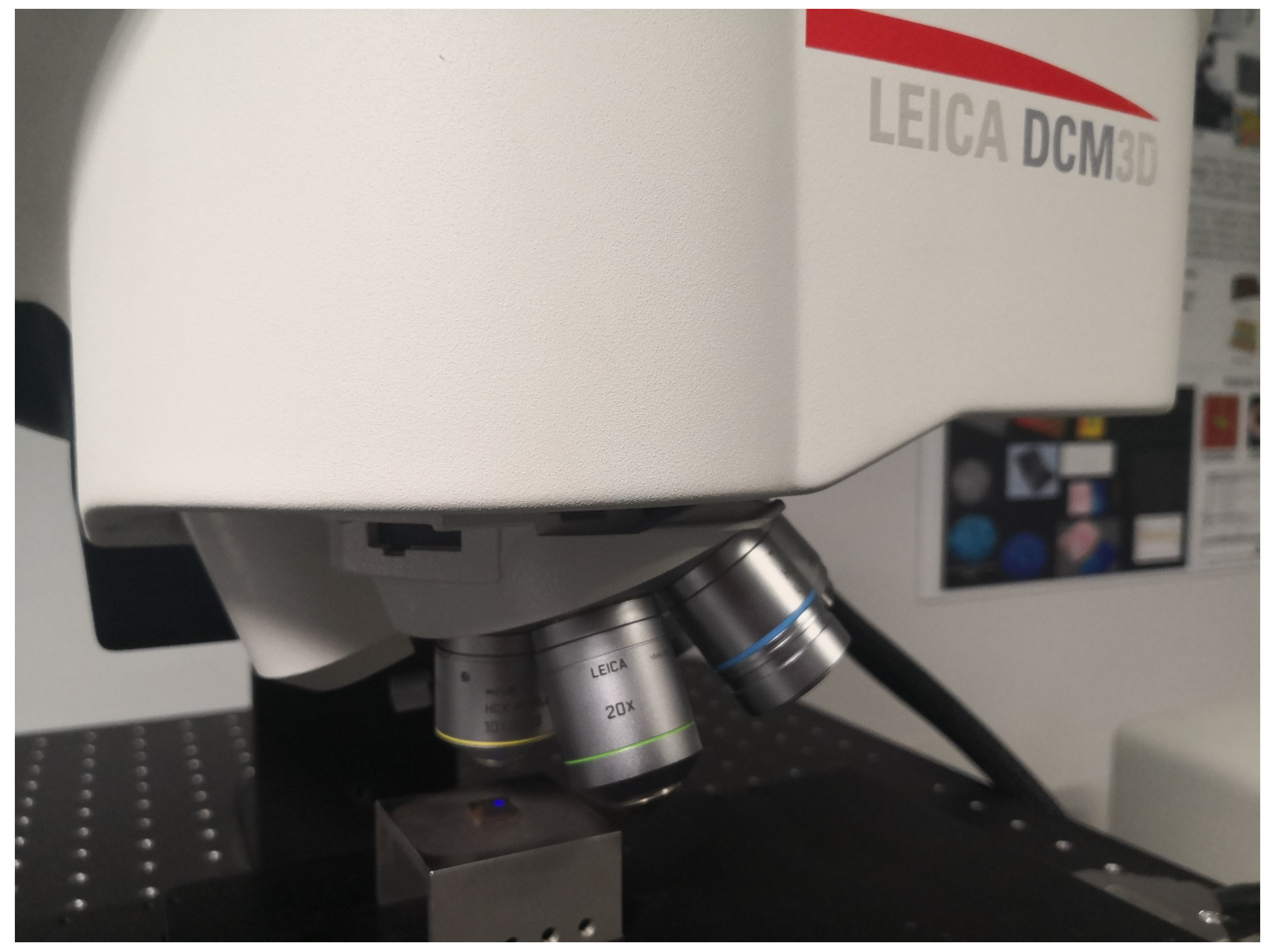
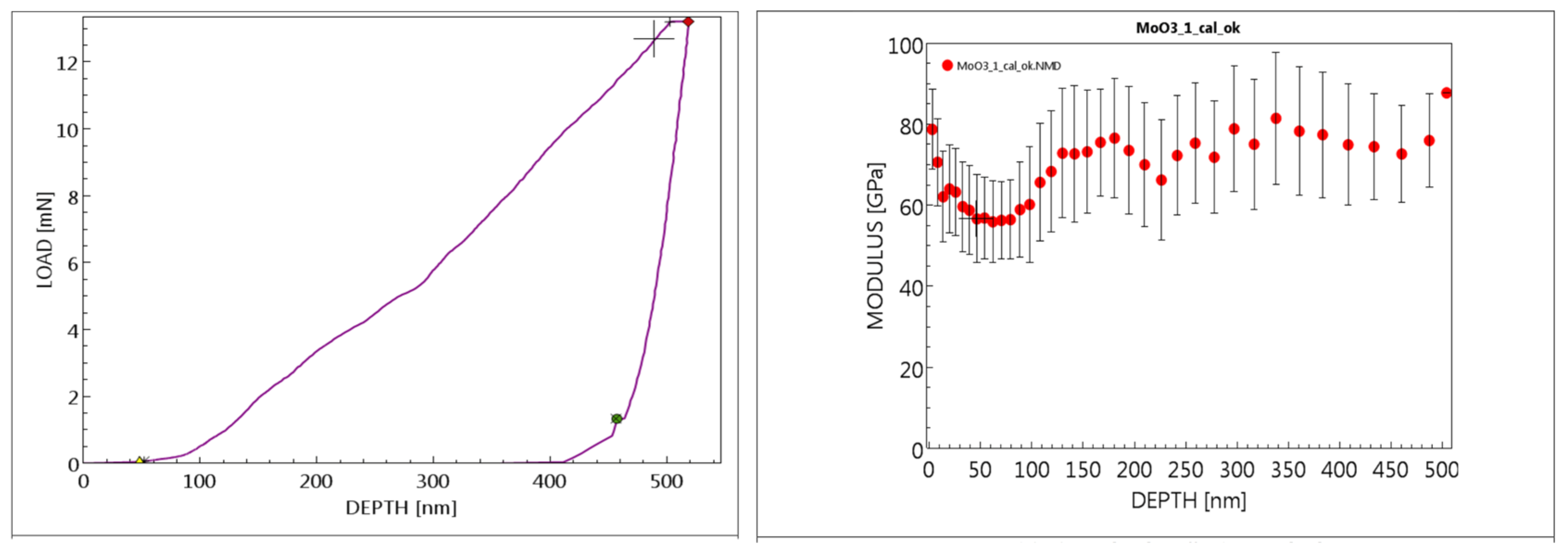

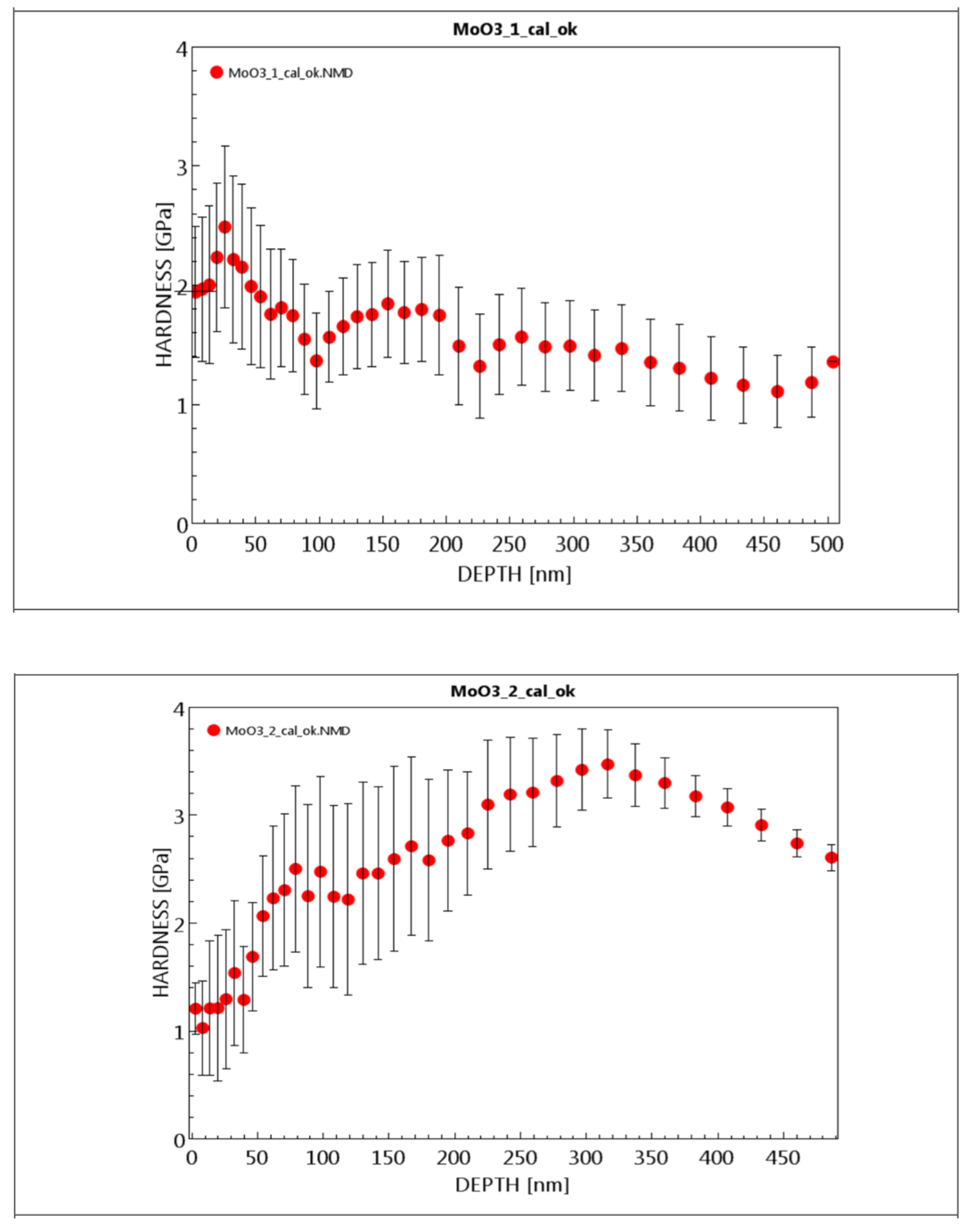
| Film | Ts (°C) | p(O2) (mbar) | Deposition Time (min) |
|---|---|---|---|
| MoO3-01 | 380 | 10−3 | 15 |
| MoO3-02 | 370 | 2 × 10−3 | 22 |
| MoO3-03 | 365 | 10−1 | 20 |
| MoO3-04 | 350 | 10−1 | 10 |
| MoO3-05 | 400 | 2 × 10−1 | 20 |
| MoO3-06 | 300 | 2 × 10−1 | 20 |
| Tip | Berkovich |
|---|---|
| Mode | Standard CSM |
| Indentation | 5 × 3 matrix |
| Max. depth | 500 nm |
| Sample | Sa (µm) | Ra (µm) |
|---|---|---|
| MoO3-01 | 0.201 | 0.175 ± 0.035 |
| MoO3-02 | 0.115 | 0.083 ± 0.019 |
© 2019 by the authors. Licensee MDPI, Basel, Switzerland. This article is an open access article distributed under the terms and conditions of the Creative Commons Attribution (CC BY) license (http://creativecommons.org/licenses/by/4.0/).
Share and Cite
Scifo, J.; Marcelli, A.; Spataro, B.; Hampai, D.; Dabagov, S.; Sarti, S.; Di Trolio, A.; Moscatelli, R.; Macis, S.; Faillace, L. Molybdenum Oxides Coatings for High Demanding Accelerator Components. Instruments 2019, 3, 61. https://doi.org/10.3390/instruments3040061
Scifo J, Marcelli A, Spataro B, Hampai D, Dabagov S, Sarti S, Di Trolio A, Moscatelli R, Macis S, Faillace L. Molybdenum Oxides Coatings for High Demanding Accelerator Components. Instruments. 2019; 3(4):61. https://doi.org/10.3390/instruments3040061
Chicago/Turabian StyleScifo, Jessica, Augusto Marcelli, Bruno Spataro, Dariush Hampai, Sultan Dabagov, Stefano Sarti, Antonio Di Trolio, Riccardo Moscatelli, Salvatore Macis, and Luigi Faillace. 2019. "Molybdenum Oxides Coatings for High Demanding Accelerator Components" Instruments 3, no. 4: 61. https://doi.org/10.3390/instruments3040061
APA StyleScifo, J., Marcelli, A., Spataro, B., Hampai, D., Dabagov, S., Sarti, S., Di Trolio, A., Moscatelli, R., Macis, S., & Faillace, L. (2019). Molybdenum Oxides Coatings for High Demanding Accelerator Components. Instruments, 3(4), 61. https://doi.org/10.3390/instruments3040061






